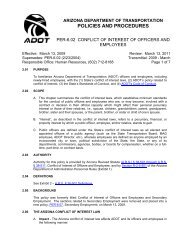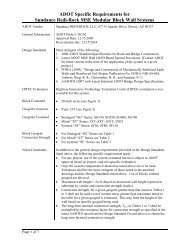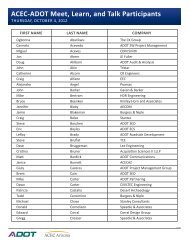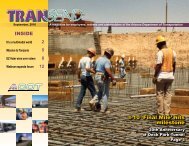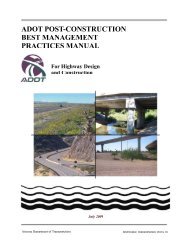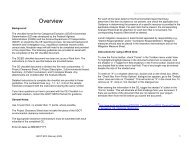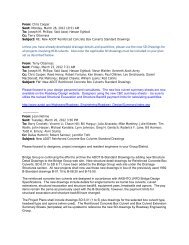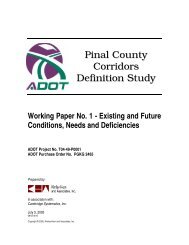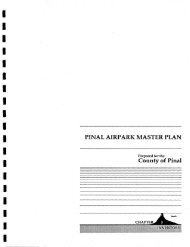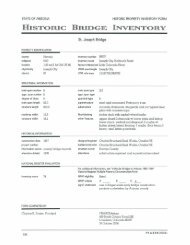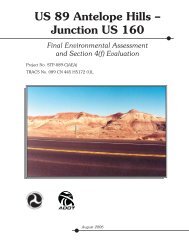I-10 Twin Peaks Traffic Interchange, Environmental Assessment
I-10 Twin Peaks Traffic Interchange, Environmental Assessment
I-10 Twin Peaks Traffic Interchange, Environmental Assessment
You also want an ePaper? Increase the reach of your titles
YUMPU automatically turns print PDFs into web optimized ePapers that Google loves.
Affected Environment and <strong>Environmental</strong> Impacts October 2005<br />
These effects, however, are market driven. Properties with easy access to an<br />
interstate become more desirable for service-oriented businesses; therefore, it is<br />
likely that property values in the vicinity of the <strong>Twin</strong> <strong>Peaks</strong> Road TI would increase<br />
substantially after completion of the <strong>Twin</strong> <strong>Peaks</strong> Road TI. As a result, businesses<br />
may choose to sell existing properties and relocate their businesses to parcels of<br />
lesser value.<br />
Access<br />
SNP 1988 General Management Plan (GMP) stated a desire to close Picture<br />
Rocks Road through the SNP, if the <strong>Twin</strong> <strong>Peaks</strong> Road TI is constructed. SNP is<br />
updating its GMP currently and the NPS is obtaining public comments and<br />
developing proposed uses for the Park; however, the closure of Picture Rocks<br />
Road through SNP does not appear in any of the alternatives currently under<br />
consideration. Because the closure of Picture Rocks Road is not proposed<br />
currently and any proposed closure would be subject to environmental and public<br />
review based upon its own merits, the impacts of the closure of Picture Rocks<br />
Road are not discussed in this EA.<br />
Conclusion<br />
Secondary impacts to land use and access may occur with the completion of the<br />
preferred alternative. These may include changes to land uses near the <strong>Twin</strong> <strong>Peaks</strong><br />
Road TI and access through the SNP.<br />
Cumulative Impacts<br />
According to the CEQ, cumulative effects are defined as the impacts on the<br />
environment that result from the proposed action when added to other past,<br />
present, and reasonably foreseeable future actions. The cumulative effects of this<br />
project may be undetectable when considered for its direct and secondary effects<br />
only, but may add to a measurable environmental change.<br />
The past, present, and reasonably foreseeable future actions that are considered in<br />
this analysis include the transportation projects planned over the next 20 years, as<br />
represented in the 2025 RTP, and the development expected to occur within the<br />
area. In addition, a number of conservation efforts are underway in the region and<br />
these efforts are expected to mitigate some of the development impacts. The area of<br />
analysis is the northwest portion of the Tucson metropolitan area, although air<br />
quality is discussed from an airshed perspective. For this assessment, only those “at<br />
risk” critical resources would be evaluated. These would include: land use, air<br />
quality, threatened and endangered species and natural resources, noise, and water<br />
resources. Each are discussed below.<br />
Land Use<br />
The completion of the projects contained within the RTP may result in additional<br />
development beyond those forecast in the area; however, these developments are<br />
Interstate <strong>10</strong> <strong>Traffic</strong> <strong>Interchange</strong> at<br />
<strong>Twin</strong> <strong>Peaks</strong>/Linda Vista<br />
4-<strong>10</strong>2<br />
Project No.: NH-0<strong>10</strong>-D (AIW)<br />
TRACS No.: <strong>10</strong> PM 236 H5838 01D



